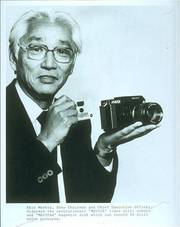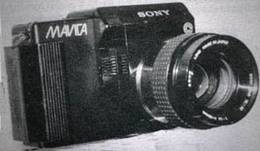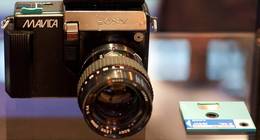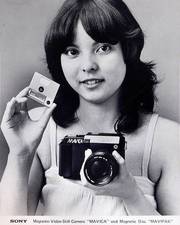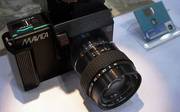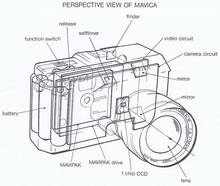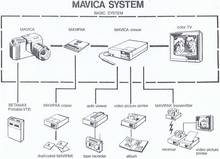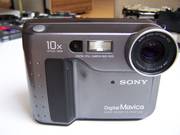Die SONY "Inventions" kommen Schlag auf Schlag
In anderen Artikeln hatte ich es schon herausgestellt, die Japaner hatten nur ganz kurze Zeit "abgekupfert". Sie haben erstaunlich schnell gemerkt, daß das Abkupfern nur ein Festhalten an alten überholten Technologien ist.
Und sie wollten den Vorsprung vor "den Anderen", auch den Vorsprung vor den Konkurrenten im eigenen Land. Herausragend war da vor allem die Firma SONY, personifiziert mit ihrem Chef Akio Morita.
In der nachträglichen Betrachtung war der junge Akio Morita ein Glückstreffer für Japan. Auch wenn der Herr Matsushita vielleicht das größere Imperium aufgebaut hatte, weltbekannt wurde SONY mit herausragenden "Entwicklungen" und bewundernswerten Strategien.
Ich spreche auch bewußt nicht von SONY "Erfindungen", denn weder die CD noch der Walkman waren SONY Erfindungen. Auch die 3 1/2" Diskette ein Jahr später war keine SONY Erfindung. Von SONY kam jedoch der Anschub der Vermarktung. Ohne SONY hätte Philips die CD nie zum Weltstandard machen können und der Walkman des Deutschen Andreas Pavel wäre irgendwo versandet.
Die CD war noch nicht reif, da kam schon wieder ein Hammer:
August 24, 1981 - SONY stellt weltweit eine absolut neue voll digitale Foto-Kamera vor. Diese allererste MAVICA (Magnetic Video Camera) basierte auf einem Bildaufnehmer-Chip und einem Diskettenlaufwerk mit magnetischen Scheiben.
Sicherlich hatte diese 1981er MAVICA noch ein paar Schwächen, legte aber den Grundstein für einen weltweiten Technologiewandel. Inzwischen gibt es in 2012 so gut wie keine analogen Kameras mehr zu kaufen und 35mm Filme entwickelt auch fast keiner mehr.
.
Durch Zufall hat uns ein Fan diese Unterlagen von 1981 zugeschickt:
Diese Seiten wurden auf der IFA im August 1981 auf dem SONY Stand verteilt. Ob damals bereits eine solche Kamera ausgestellt wurde, ist nicht mehr bekannt.
.
Announcement
SONY CORPORATION
7-35 KITASHINAGAWA S-CHOME, SHiNAGAWA-KU, TOKYO,
August 24, 1981 - Revolutionary Video Still Camera Called "MAVICA" Disclosed by Sony
- Newly Developed Magnetic Disk Called "MAVIPAK" Used -
Sony Corporation today announced that it has developed a revolutionary video still camera, embodying fully the advantages of advanced electronic technology in magnetic recording, CCD and IC semiconductors.
Called the MAVICA system, the new magnetic video still camera uses no photographic film and therefore does not require developing and printing processes which are indispensable to conventional chemical photography. This new video still camera represents an epoch-making innovation in the history of still photography.
The conventional camera has seen some improvements over the years, such as the change from dry plate to film, the use of electronics in certain parts, and the reduction of size and weight. However, for more than 140 years since the invention by Daguerre of France, there has been no fundamental change in the concept and technology of photography, in which images are recorded on film through chemical reactions of photo-sensitive materials.
The MAVICA system
Sony's MAVICA system replaces such chemical processes with an electromagnetic system. The MAVICA is no larger than a conventional 35mm single-lens reflex camera. An image that comes through the lens is converted into electronic signals by a solid-state imager called CCD (Charge Coupled Device), previously developed by Sony. The signals are recorded on a very small magnetic disk called MAVIPAK that Sony has developed for the new camera system.
The newly developed memory medium called MAVIPAK can record 50 still color pictures. The recorded pictures can be viewed immediately on the home TV set through a specially designed playback unit called the MAVIPAK Viewer. MAVIPAK pictures require no developing or printing processes such as required in chemical photography. It is expected that hard copies of color pictures can be produced from the MAVIPAK by means of a new color printer now under development by Sony.
The MAVICA (Eigenschaften der Kamera)
The MAVICA has many features which the conventional camera does not have:
- It can show the pictures taken immediately on a TV set.
- Continuous recording of 10 pictures per second can be obtained. (Picture-taking speeds of up to 60 per second could be attained.)
- Through electronic means, the user can produce a composite picture or control the color tone readily.
- Image signals on the MAVIPAK can be transmitted elsewhere over a telephone line.
- The MAVICA can be used as a handy color video camera, when connected to portable or other VTRs.
- Still pictures taken by the MAVICA can be easily dubbed onto a videotape, so that the user can make video albums.
The MAVIPAK (Eigenschaften des Speichermediums)
The MAVIPAK (also die 2" Diskette)has the following features:
- The MAVIPAK (60mm x 56mm x 3mm) weighs only 8 grams and can be easily filed or mailed.
- The magnetic recording disk of the MAVIPAK is contained in a flat, hard, easy-to-handle case.
- A MAVIPAK that has been recorded on part of the disk can be removed from the camera and then inserted again later with no fear of recording a new picture over a previous picture. The camera will automatically record on a fresh portion of the disk for subsequent pictures.
- What is recorded on the MAVIPAK can be erased, so that the memory disk can be used again and again.
- MAVIPAKs are inexpensive and easy to handle. (Even children can reload them easily.)
- There is no deterioration of picture or color quality.
- Compared with slides, the new system permits quick access to any picture the viewer wants in the MAVIPAK.
MAVICA camera Specifications
Type of camera: TTL single-lens reflex
Lens mount: Bayonet type
Lenses available: 25mm F2.0 and 50mm F1.4 4 times zoom (16mm ~ 64mm) F1.4
Exposure measurement: TTL center-weighted metering
Filter: Indoor-outdoor switch attached
Self-timer: Electronic control
Frame advance: Automatically advanced by release button
Recording capability: Continuous recording possible (variable speed)
Recording system: Luminance signal: FM
Chrominance signal: FM color differential
Horizontal resolution: 350 TV lines
Color band width: 1 MHz
Image S/N: 45 dB
Image sensor: Narrow-channel frame transfer CCD (with overflow drain)
Image elements: 570 horizontal x 490 vertical (app. 280,000 elements)
Size: 130mm x 89mm x 53mm
Weight: 800 grams (including battery)
Power source: 3 Ni-Cd rechargeable batteries (200 pictures per charge)
Playback: MAVIPAK Viewer (supplied), RGB output or NTSC output
Heute in 2013 haben diese Kameras völlig irre Eigenschaften
Die letzten MAVICAs konnten am Ende noch CDs beschreiben, dann kam der Memory Stick als Speicher und dann die handelsüblichen Speicherkarten bis 128 Gigabyte.
Die digitalen Kameras selbst der Consumer-Klasse können jetzt HD Filme aufnehmen und dazu auch noch den Ton. Die Wechselobjektive sind schon lange out, excellente Zoom Optiken erledigen das. - Eine der moderneren Kameras hat inzwischen jede Menge Anschlüsse zu jedem Computer und es wird ständig mehr.
Ob man das alles wirklich noch braucht, steht auf einem anderen Blatt.
.
- Hier nochmal einen Blick auf unsere erste MAVICA.
- http://technikwissen.ipw.net/kodak-z650.html
- http://ipw.ipw.net/archiv-start.html
.

